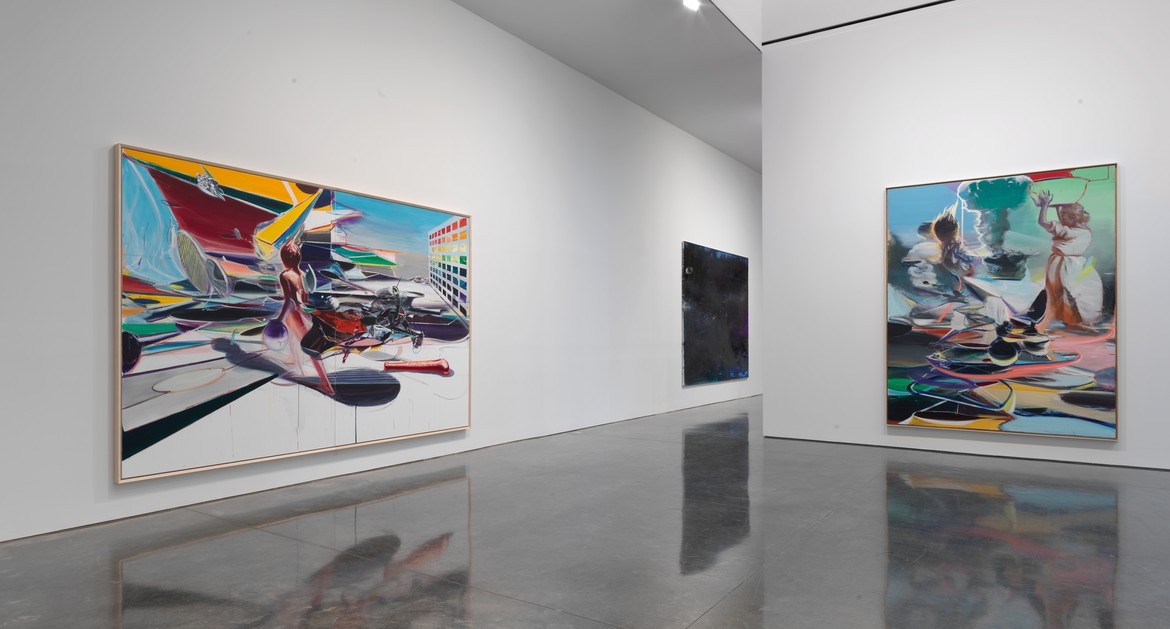Jia Aili
Combustion
07 Mar - 13 Apr 2019
JIA AILI
Combustion
7 March – 13 April 2019
Art is the light of the spirit. It enlightens the dust of the mind.
—Jia Aili
Gagosian is pleased to present Combustion, Jia Aili’s first exhibition in New York, and with the gallery.
A central figure in contemporary art in China, Jia creates dynamic compositions that both emerge from and challenge art historical assumptions in the context of a rapidly changing world. In his epic tableaux, which move between genre painting, portraiture, fantasy, and abstraction, he reflects on the dramatic modernization of society while probing the vulnerabilities of the existential human condition. New meaning emerges out of this interweaving of disparate narratives.
The exhibition includes twenty-nine paintings from the past ten years, grouped into four sections to trace the evolution of Jia’s oeuvre. In the four-panel Sonatine (2019), condensed polyhedrons move through the air, filled with autonomous scenes related to Jia’s earlier paintings. Like musical notes, colors are emancipated from their illusionistic and representational functions while multidimensional shapes tessellate into a cohesive whole—as the title suggests “small sonatas” visually unfolding. Jostling against each other, the abstract planes and anonymous figures seem to suggest a new internal realm where traditional perspective is fragmented and replaced with a timeless panoramic view: a future landscape of grafted, inchoate memories.
Within Jia’s invented spaces, archetypes recur, each of which is related to a certain time or cultural context. Human figures, multidimensional geometries, and fragments of architecture, land, and machinery are juxtaposed to create what Jia calls “a structured constellation of history,” fusing past and present in kaleidoscopic amalgamations. This conceptual and visual pursuit has its roots in an earlier series of paintings entitled The Wasteland. In an untitled painting from 2013, a man in a white hazmat suit stands at the center of an ambiguous, dark space, his impossibly large, round torso verging on either sinister or comical; and in another from 2016, a skeleton seems to grasp at a fiery version of itself, a close-up view of the ominous “combustion” that appears in more discreet vignettes throughout the exhibition. In Hermit from the Planet (2015–16), three small figures set against a broad expanse of cracked earth and stormy skies cower as electric currents pulse out of round voids and a Sputnik-like metallic sphere floats above the scene. Elements of these disquieting works appear in more recent vividly colored paintings, where compositional fracture gives rise to a revelatory pluralism—historical imagery merging with personal interpretation, and quotidian moments merging with extraordinary potentialities.
For Jia, art exudes its greatest power when modes of human awareness are dislocated. Thus, his unsettling worldviews call for the reconsideration of complex knowledge systems as a means of discovering illuminated paths through the darkening context of technological process.
Combustion
7 March – 13 April 2019
Art is the light of the spirit. It enlightens the dust of the mind.
—Jia Aili
Gagosian is pleased to present Combustion, Jia Aili’s first exhibition in New York, and with the gallery.
A central figure in contemporary art in China, Jia creates dynamic compositions that both emerge from and challenge art historical assumptions in the context of a rapidly changing world. In his epic tableaux, which move between genre painting, portraiture, fantasy, and abstraction, he reflects on the dramatic modernization of society while probing the vulnerabilities of the existential human condition. New meaning emerges out of this interweaving of disparate narratives.
The exhibition includes twenty-nine paintings from the past ten years, grouped into four sections to trace the evolution of Jia’s oeuvre. In the four-panel Sonatine (2019), condensed polyhedrons move through the air, filled with autonomous scenes related to Jia’s earlier paintings. Like musical notes, colors are emancipated from their illusionistic and representational functions while multidimensional shapes tessellate into a cohesive whole—as the title suggests “small sonatas” visually unfolding. Jostling against each other, the abstract planes and anonymous figures seem to suggest a new internal realm where traditional perspective is fragmented and replaced with a timeless panoramic view: a future landscape of grafted, inchoate memories.
Within Jia’s invented spaces, archetypes recur, each of which is related to a certain time or cultural context. Human figures, multidimensional geometries, and fragments of architecture, land, and machinery are juxtaposed to create what Jia calls “a structured constellation of history,” fusing past and present in kaleidoscopic amalgamations. This conceptual and visual pursuit has its roots in an earlier series of paintings entitled The Wasteland. In an untitled painting from 2013, a man in a white hazmat suit stands at the center of an ambiguous, dark space, his impossibly large, round torso verging on either sinister or comical; and in another from 2016, a skeleton seems to grasp at a fiery version of itself, a close-up view of the ominous “combustion” that appears in more discreet vignettes throughout the exhibition. In Hermit from the Planet (2015–16), three small figures set against a broad expanse of cracked earth and stormy skies cower as electric currents pulse out of round voids and a Sputnik-like metallic sphere floats above the scene. Elements of these disquieting works appear in more recent vividly colored paintings, where compositional fracture gives rise to a revelatory pluralism—historical imagery merging with personal interpretation, and quotidian moments merging with extraordinary potentialities.
For Jia, art exudes its greatest power when modes of human awareness are dislocated. Thus, his unsettling worldviews call for the reconsideration of complex knowledge systems as a means of discovering illuminated paths through the darkening context of technological process.

